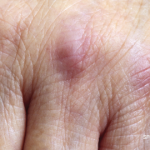A 60-year-old man returns for a follow-up related to his diagnoses of rheumatoid arthritis and chronic gout of his right ankle and foot, without tophi. He reports the gout flares have subsided in his ankle. He takes 450 mg of allopurinol daily. He has rheumatoid factor-positive rheumatoid arthritis, which previously affected multiple sites, without organ…
Search results for: weight

3 Tips to Optimize Practice Performance
Rheumatologists can build resilience through recovery and reframing, transforming stress so that it enhances performance…
Coding Corner Question: A Quiz on Modifiers
Which modifier is used when there is a separate and/or identifiable reason to bill for both an evaluation and management code and a procedure code? -25 -24 -51 -59 Which modifier is used to indicate that bilateral procedures were done on a patient? -50 -LT/RT Both a and b None of the above A 68–year-old…

7 Smartphone Tools for Rheumatologists
CHICAGO—Suleman Bhana, MD, a rheumatologist at New York-based Crystal Run Healthcare, calls himself a “technology nerd,” but judging by his review of tech tools at the 2018 ACR/ARHP Annual Meeting, you don’t have to geek out to embrace technology in your rheumatology practice. You just have to like simplicity and saving money. “We have a…

Rheumatologists Debate Hydroxychloroquine Dosing Guidelines for Lupus
CHICAGO—The correct dosing of hydroxychloroquine (HCQ) for systemic lupus erythematosus (SLE) is a concern of all rheumatologists. Petros Efthimiou, MD, clinical professor of medicine at New York University, New York City, opened the Great Debate of the 2018 ACR/ARHP Annual Meeting by stating, “Today, we will be discussing a critical clinical problem that affects everyone’s…

These 3 Tough Cases from the 2018 Thieves Market Underscore Need for Clinical Diligence
CHICAGO—In the Thieves Market session at the 2018 ACR/ARHP Annual Meeting, rheumatologists from around the country presented a slate of challenging cases that emphasized the importance of clinical persistence and attention to detail, and the need to consider diagnoses that might not be common or obvious. Three of them are summarized below. (Look for more…

Cancer-Associated Myositis: A Case Report & Review of the Literature
Since it was first reported in 1916, a correlation between inflammatory myopathies and cancer has been noted in several studies. Population studies have confirmed this relationship, and the phrase cancer-associated myopathy has entered the vernacular. Over the past decade, research efforts have shifted toward revealing associations between autoantibodies and clinical phenotypes. One subset of auto-antigens…
Does Loss of Skeletal Muscle Mass Increase the Risk of Knee OA?
Obesity is a well-known risk factor for knee osteoarthritis (OA), but data regarding the association of body composition (fat and muscle mass) with the risk of knee OA are lacking. Thus, it is not clear whether the effects of BMI, typically interpreted as effects of obesity, are truly due to excess adiposity rather than to overall loading due to the combined weight of body mass. Misra et al. undertook this study to examine the longitudinal association of body composition categories based on fat and muscle mass with the risk of incident knee OA…
Coding Corner Answers: Billing for Joint Injection within a Series
Take the challenge. CPT: 20611-LT, J7325-EJ ICD-10: M17.12, E66.01, Z68.41 Coding/Billing Rationale No evaluation and management (E/M) code was added because there was no significant and/or separate identifiable reason for an E/M service to be billed with this scheduled visit for her series of injections. The joint injection was billed with ultrasound guidance due to…
Coding Corner Question: Billing for Joint Injection within a Series
A 68-year-old female Medicare patient with a diagnosis of primary osteoarthritis of the left knee returns to a practice for her third injection in a series of knee injections. She reports being able to resume her after-dinner walks, which last for 30–40 minutes at least twice weekly. She denies fevers or any rashes. She has…
- « Previous Page
- 1
- …
- 33
- 34
- 35
- 36
- 37
- …
- 93
- Next Page »